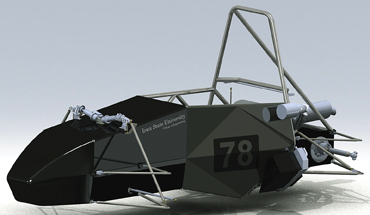Iowa State’s Formula SAE Team tests its engineering skills at international competition
05-06-11

Iowa State's Formula SAE Team has designed a lighter, tighter, simpler mini race car for this year's Formula SAE Series. Image by Formula SAE Team.
Contacts:
Andrea Fox, Formula SAE Team, 847-458-2323, alfox@iastate.edu
Kyle Dickinson, Formula SAE Team, 515-331-3174, kyled@iastate.edu
James Whisler, Formula SAE Team, 651-687-9487, jwhisler@iastate.edu
Mike Krapfl, News Service, 515-294-4917,
mkrapfl@iastate.edu
Iowa State’s Formula SAE Team tests its engineering skills at international competition
AMES, Iowa - Members of Iowa State's Formula SAE Team are going flat out to build a mini racing car that can show off their engineering skills.
Designs for a super-light, 350-pound car are all drawn up. The chassis is welded. The single-cylinder, 450-cubic-centimeter motorcycle engine is rebuilt and mounted. The suspension control arms and uprights are manufactured.
"The car is 80 percent there, but there is a lot of work left in that 20 percent," said James Whisler, a senior in mechanical engineering from Eagan, Minn., and a team veteran.
And so team members are showing up at the garage during finals week to get their open-wheel racer on four wheels. They want to show the judges at the Formula SAE Series competition May 11-14 at Michigan International Speedway that they know something about engineering a good race car. The annual competition is sponsored by SAE International, formerly known as the Society of Automotive Engineers. The Iowa State team will compete against 121 entries, including teams from Austria, Brazil, Canada, Germany, Japan, South Korea and Venezuela.
Iowa State's team will show off their engineering skills during a technical inspection, a cost and manufacturing analysis, a business presentation and an engineering design analysis.
But, team members said, time is running out to get a car ready for the competition's five driving events; Iowa State's team is not likely to turn wheels on the track. They're disappointed about that. But they vow to work through the summer so they can test the car under racing conditions. And that will provide important data that could improve next year's car.
They're also vowing to learn a few lessons from the challenges of raising $12,000 and designing, building and testing all the components that go into a new race car every school year.
"The biggest thing is organization within the team and being committed to an excellent project result," said Andrea Fox, a senior in hotel, restaurant and institution management from Algonquin, Ill., and the team's project director. "We need to learn how to organize the team effectively, for maximum, on-time results."
Even with its setbacks, the team will have some innovations to show the judges: body panels as structural elements of the chassis, changes in suspension geometries, smaller wheels and a new engine control unit.
Yes, said Kyle Dickinson, a senior in mechanical engineering from Urbandale and another team veteran, the team has made some engineering strides: "This year's car is light and small with real tight packaging and 60 percent of its weight in the back."
So it's a well-engineered car?
Well, said Whisler, "We'll know when we drive it."
-30-